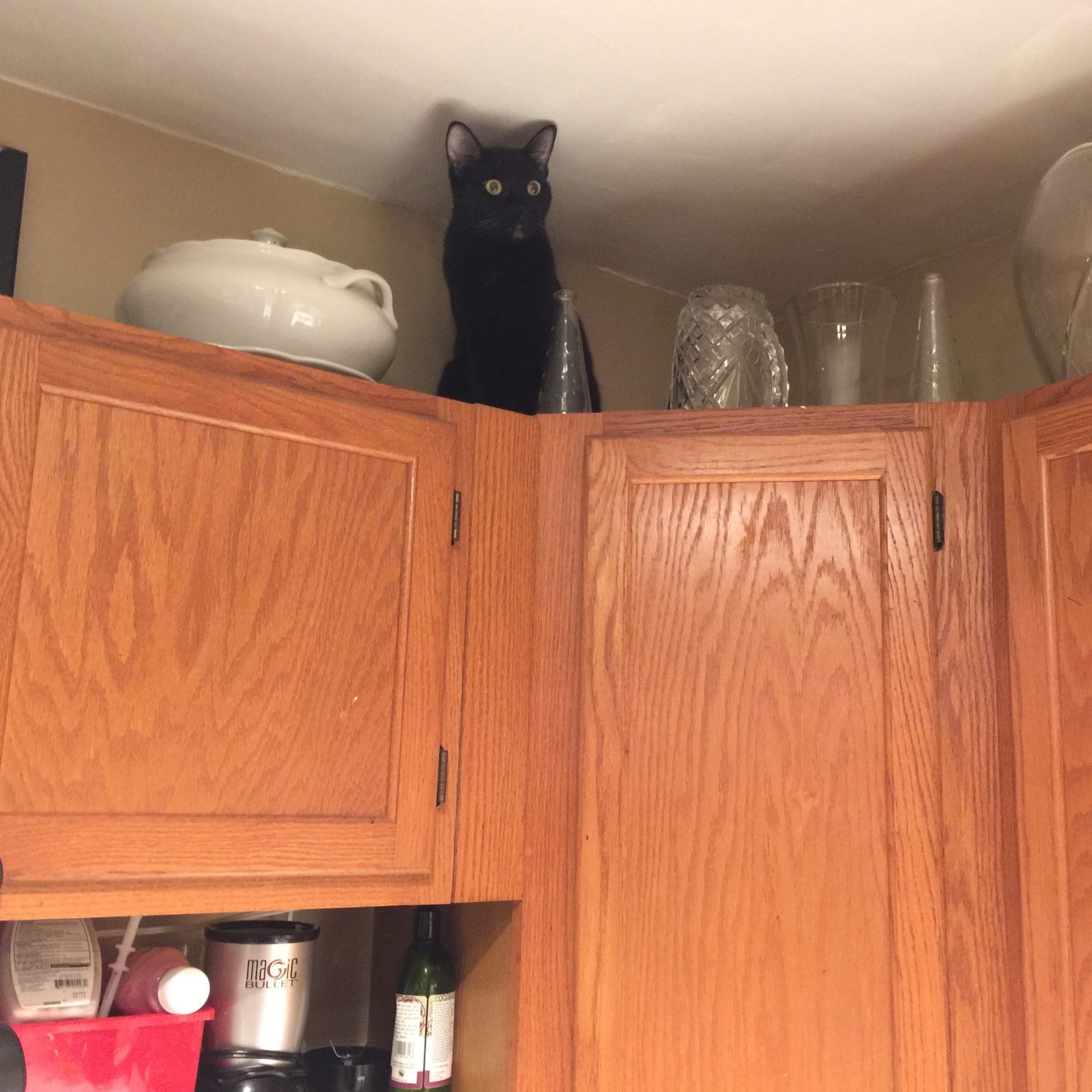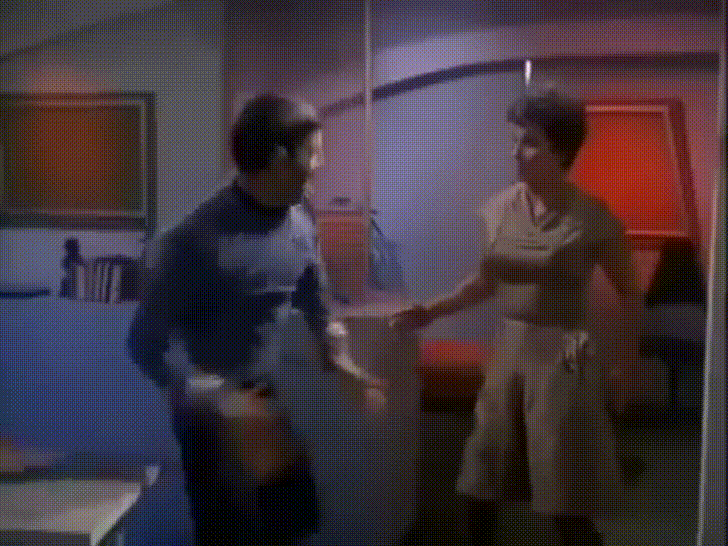Cat Person
A short biography of a cat I had the mixed fortune to live with and a reflection on Star Trek, "The Man Trap"
Giovanni Pierluigi da Palestrina, 1525-1594, was an Italian Renaissance composer of church music. By “church music” I don’t mean a bunch of midwestern Lutherans perfunctorily chanting “A Mighty Fortress is our God” before hitting the Perkins brunch buffet—Palestrina wrote the sort of music you’d imagine angels singing before hitting the Perkins brunch buffet. His masses and motets are cathedrals of sound, great vaulted chambers with arched roofs and lush, flowing frescoes depicting Biblical scenes lined in gold filigree. He represents the pinnacle of Renaissance polyphonic music, in which a series of independent voices find their own paths through alternating shades of dissonance and the sweetest consonances, a seemingly endless series of resolutions each more satisfying than the last.
Palestrina is also a city in Italy, which my former Boston landlord, an Italian immigrant named—what else?—Tony, described as “a dirty city dominated by a mountain covered with TV antennas.” I’d have to take his word for it; Palestrina looks pretty attractive in Internet photos, but then, so does Carbondale, Illinois. What do I know of any of this?
When I think of Palestrina I think of the cat I owned for about fourteen years; a striking black and white cat with a charming face and a terrible disposition. I adopted Palestrina and her brother Dmitri not too long after moving into my first apartment, a tiny studio in Murfreesboro, Tennessee that had a strict no pets policy. That transgression ultimately earned me a lengthy and passionate recrimination from the apartment’s owner, a middle-aged woman who was too motherly to incur a financial penalty. Honestly the lecture I received was worse anyway.
She had recognized what I was unable to see: that I was an irresponsible child inexplicably endowed with the legal right to enter into contracts. I was equally remiss with my pets, failing to get either cat fixed and so dooming Palestrina to become gravid as soon as her machinery was ready to go. Over the summer I’d moved into a dumpy little ranch-style with a couple college friends, Brian and James, and she gave birth to four kittens in my bedroom closet while James’ two dogs barked outside the bedroom door. So suddenly I had six cats.
This was not a sustainable pattern. When the kittens were old enough I dumped them in my car—just loose, clambering onto my shoulders and crawling around under the brake pedal—and took them to the vet to get snipped. It was an adulting moment for me, and like most adult things it cost more money then I felt comfortable parting with. I moved again, into a seedy little apartment complex with Brian, and for six weeks neither of us were able to get a shred of sleep without all four kittens climbing around on our heads like tiny alpinists. Bryan threw another dog into the mix, an ungovernable yellow lab named Basil who promptly destroyed all the furniture, chewed a hole in the bathroom door, and wolfed down cat turds from the litter box like they were Tootsie Rolls. All seven members of our menagerie set about demolishing the apartment with industry and zeal until one day the management found out. They told us to get rid of the animals.
After much casting about in search of a landing place for my feline tribe, Brian told me they could go live on his parents’ farm. And so I parted ways with them. At the last minute, however, I withheld Palestrina. We kept leasing the gutted apartment and for whatever reason—probably something to do with the more pressing issue of periodic gunfire in the parking lot—the management forgot about us. Perhaps as though she was aware that her behavior was no longer endangering my domestic bliss, Palestrina adopted the habit of urinating on everything I owned. I discovered this while sitting in class one day waiting my turn to give a presentation on the music of the French composer Roland Dyens. Shortly after arriving and taking my seat I became aware of a sharp, ammonic odor, which I quickly traced to the previously unnoticed large yellow stain on my white button-down shirt.
And thus we settled into a life together, scholar and cat. I took her with me to Cincinnati where I attended graduate school. She was always happy to see me at the end of the day, and I was always glad for her companionship, but she never stopped soiling everything I owned. When I married in 1997 my wife was less forgiving of her foibles, and Palestrina responded to her ire by taking the occasional dump on her pillow.
Around 2007 she developed a disorder that prevented her from absorbing nutrients, and after a few weeks of declining health we had her put to sleep. I still miss her. Pets are funny that way: we take into our houses these small—or sometimes not so small—animals, to soothe us and entertain us. They, in turn, conjure up a life that is often orthogonal to our desires, and yet for the most part we accept it; the pain of wiping up a pool of vomit from between the couch cushions is just part of the deal.
We now have four cats. One of them barfs somewhere inconvenient about once a week; one of them regularly pisses on the kitchen floor; one brings half-eaten rodents into the basement and leaves them to rot for a week before we notice the smell; and one will literally eat the food off your dinner plate if you leave the room for more than four or five seconds—he once tried, while my head was turned, to take a bite of a burrito I was holding. We deal with it and we tell each other helplessly that four cats is about two too many, but somehow we love them for the most part. Sometimes though I look back wistfully to simpler times and the halcyon days of my dear Palestrina squatting alone in the laundry basket.
Star Trek: “The Man Trap”
As previously mentioned, I am laboring my way through all 79 episodes of Star Trek, the original series, and depositing a brief hairball of thoughts on each as I go. Here follows the first in the series.
“The Man Trap” was the sixth episode of Star Trek to be shot but the first aired because the monster-of-the-week format was simple enough—it was felt by some jejune executive—to appeal to chum like you and me. I tend to get it mixed up with “Obsession,” in which a spangly floating cloud sneaks up on people and absorbs their hemoglobin while they execute awkward blocking that allows them to look in every direction but the one that would point them even vaguely toward what would surely be a visually striking sort of peril. It’s pretty much the exact same episode, except that here the cloud is a shape-shifting ape with the mouth of a lamprey, octopus suckers all over its paws, and for some inexplicable reason, a blonde wig. And instead of sucking hemoglobin it sucked ass. Sorry, I mean salt. As in, all the salt in a victim’s body.
It’s hard to see “The Man Trap” as anything but embarrassing, owing particularly to the anorexic backstory in which Leonard McCoy meets up with an old flame. This, remember, is our introduction to the good doctor—we are told he is a man with a past, but between the wooden acting and the nonsensical script his past seems more like the brand sticker on a snapback hat. It’s full of sound and furry—as we discover when his sweetheart turns out to be the monster in disguise—and signifies nothing; this one remembered affair standing like an obelisk on an empty plain, is never mentioned again in the entire run of the show or beyond.
The episode is also casually sexist: Janice Rand, played by Grace Lee Whitney wearing what appears to be a woven basket on her head, suffers the following exchange with two leering crew members as she carries a tray full of weird brightly colored cubes that I swear to God are made out of —food, we are given to believe—down a corridor:
(REDSHIRT gives RAND a languorous visual examination, visibly salivating)
RAND: Why don't you go chase an asteroid?
REDSHIRT: Hey, Janice, is that for me?
RAND: Don't you wish it was?
BLUESHIRT: How about that?
REDSHIRT: Yeah, how'd you like to have her as your personal yeoman?
Workplace sexual harassment was hilarious in the 60s, at least for the people writing the checks.
This wouldn’t be quite so grievous if it went somewhere, but like McCoy’s erstwhile romance, which is mostly played out through side remarks to conversations about other topics, it’s all just empty filler. Someone once told me that the corridor sets for Star Trek were marked on the outside, “goes nowhere, does nothing.” It’s an apt descriptor of about half the dialog in “The Man Trap.” It doesn’t further the plot, it doesn’t establish character—not any character that persists beyond the episode anyway—and it doesn’t make any kind of cogent philosophical or moral argument. I suspect it’s there to give the suggestion that these people have lives beyond the imperatives of plot, but as a mind-bogglingly cheap production (Shatner once remarked that Star Trek was produced for less than the catering budget of some other shows), the program was at its best a Thornton Wilder sci-fi play—good writing doesn’t need paper-mâché and gold paint. In the same way we see the production designers adding one or two lonesome details to an otherwise barren set piece, the scripts often contain pointless curlicues intended to add flesh to the bones but which instead serve merely to draw attention to the show’s austerity.
It’s a miracle Star Trek survived its initial brush with broadcast reality. And it wasn’t even the first time producer Gene Roddenberry had touched off a damp squib. I suspect that a significant proportion of the American public, distressed at the assassination of John Kennedy less than two years earlier, the ongoing bloody disaster of Vietnam, and the continuing failure of the U.S. space program to eclipse Soviet triumphs, craved even a small glimpse of a clean, bright world founded on high technology and the fluent confidence of a group of supremely competent heroes. “The Man Trap” contains that, bizarre clasp-fisted melee techniques notwithstanding.
And it would get better.
Welcome back, gentle readers! Year two of the Red Clay Bestiary is upon us. I hope you enjoy the torrent of words even now barreling down whatever pipe it is in my head they come out of. I’ll inundate you as usual but half the Star Trek essays will be members only at least for the time being. It’s not too late to sign up: go here and get yourself a yearly subscription to receive a lovely hand-printed Red Clay Bestiary t-shirt and a monthly limited edition screen print (6” x 9”) of twelve fascinating people illustrated by twelve fascinating illustrators—Kurt Vonnegut is almost a month late now but coming very soon. If you don’t have the cash to go for the full subscription, never fear, a la carte options are on the way.
Now, if you happen to have a ken to listen to me blather inanely on a variety of topics you’re in luck. My good friend Adam Cole of TruerMU was brave or crazy enough to interview me recently. It won’t be public for a couple of months yet but as a Red Clay Bestiarian you can view it ahead of schedule. And because I absolutely could not be compelled to shut up, when you’re finished with that, there’s more. You will be quizzed on this, so listen carefully, and subscribe to Adam’s YouTube channel while you’re at it. He interviews all manner of interesting folks on a regular basis; it’s totally worth your time.
Thanks as always for reading. I’ve played music to a lot of empty rooms and I can tell you it’s not much fun. All y’all make me write better. Please like, comment, and share. Cheers!







RIP Strini, you hissing, pissing legend.😹
Monteverdi is better. I jokingly told my wife I wanted to adopt 3 cats, and on my birthday she surprised me by announcing we were getting one. I told her that would be a bad idea. I've had cats and loved them, and currently have no desire to own another, the least of reasons being we have a dog that eats cats. So I said no. Which was a shame, because everyone else thought I'd jump for joy. So for my birthday I got to disappoint the entire family.